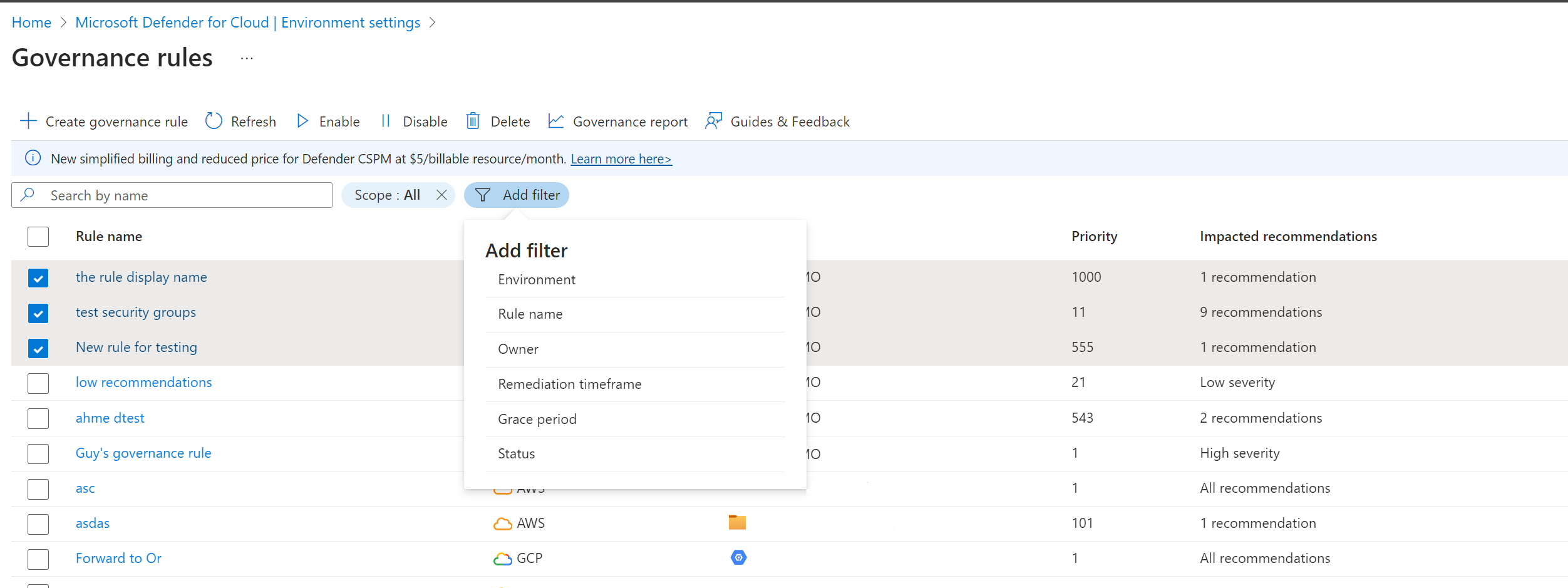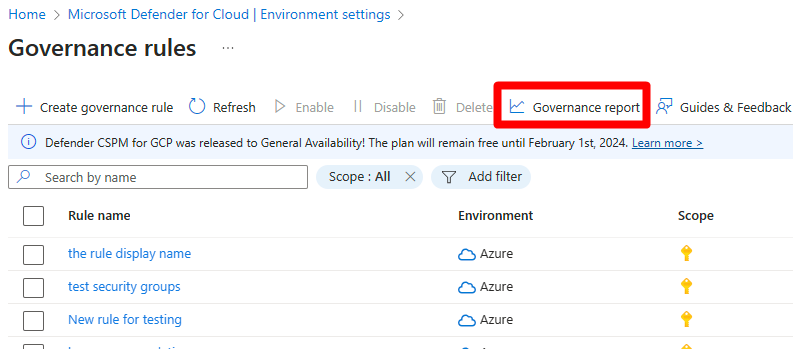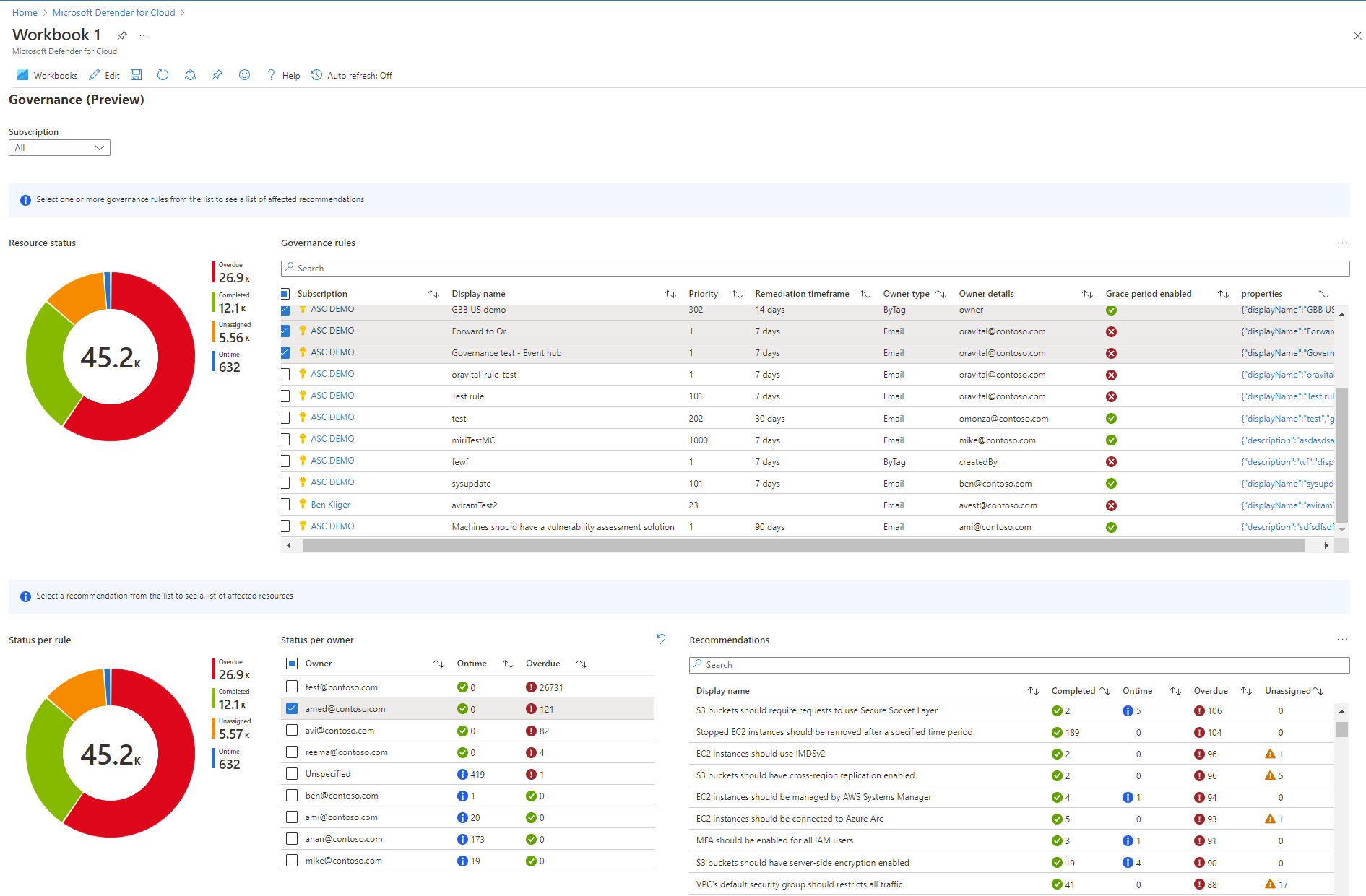Note
Access to this page requires authorization. You can try signing in or changing directories.
Access to this page requires authorization. You can try changing directories.
Security teams are responsible for improving their organization's security posture, but team members might not always follow through to implement security recommendations. Security teams can set governance rules to help drive accountability and create a service-level agreement (SLA) around the remediation process.
For an in-depth discussion around why governance rules are helpful, watch this episode of the Defender for Cloud in the field video series.
Governance rules
You can define rules that automatically assign an owner and a due date to address recommendations for specific resources. This feature provides resource owners with a clear set of tasks and deadlines to remediate recommendations.
Learn how governance rules work in the following sections.
Tracking
Track the progress of remediation tasks by sorting by subscription, recommendation, or owner. You can easily find tasks that need more attention so that you can follow up.
Assignments
Governance rules can identify resources that require remediation according to specific recommendations or severities. The rule assigns an owner and due date to ensure the recommendations are handled. Many governance rules can apply to the same recommendations, so the rule with the highest priority assigns the owner and due date.
Due dates
The due date for remediation of a recommendation is based on a time frame of 7, 14, 30, or 90 days after the rule triggers the recommendation. For example, if the rule identifies the resource on March 1 and the remediation time frame is 14 days, March 15 is the due date. You can apply a grace period so that resources that need remediation don't affect your Microsoft Secure Score.
Owners
You can also set resource owners, which helps you find the right person to handle a recommendation.
In organizations that use resource tags to associate resources with an owner, you can specify the tag key. The governance rule reads the name of the resource owner from the tag.
When an owner isn't found on a resource, associated resource group, or associated subscription based on the tag, the owner is shown as unspecified.
Notifications
By default, email notifications are sent weekly to resource owners. Emails include a list of on-time and overdue tasks.
By default, the resource owner's manager receives an email that shows overdue recommendations, if the manager's email is found in the organizational Microsoft Entra ID.
Conflicts
Conflicting rules are applied in scope order. For example, rules on a management scope for Azure management groups, Amazon Web Services (AWS) accounts, and Google Cloud Platform (GCP) organizations take effect before rules on scopes, like Azure subscriptions, AWS accounts, or GCP projects.
Prerequisites
- The Defender Cloud Security Posture Management (Defender CSPM) plan must be enabled.
- You need Contributor, Security Admin, or Owner permissions on the Azure subscriptions.
- For AWS accounts and GCP projects, you need Contributor, Security Admin, or Owner permissions on the Defender for Cloud AWS or GCP connectors.
Define a governance rule
Sign in to the Azure portal.
Go to Microsoft Defender for Cloud > Environment settings > Governance rules.
Select Create governance rule.
Specify a rule name and scope in which to apply the rule. Rules for management scope (Azure management groups, AWS master accounts, and GCP organizations) are applied before the rules on a single scope.
Note
Exclusions can't be created by using the portal wizard. To define exclusions, use the API.
Set a priority level. Rules are run in priority order from the highest (1) to the lowest (1000).
Specify a description to help you identify the rule.
Select Next.
Specify how the rule affects recommendations.
- By severity: The rule assigns the owner and due date to any recommendation in the subscription that has no owner or due date.
- By specific recommendations: Select the specific built-in or custom recommendations that the rule applies to.
To specify who's responsible for fixing recommendations covered by the rule, set the owner.
- By resource tag: On your resources, enter the resource tag for the resource owner.
- By email address: Enter the owner's email address.
Specify a remediation time frame that spans from when remediation recommendations are identified to when the remediation is due. If recommendations were issued according to the Microsoft cloud security benchmark, and you don't want the resources to affect your Secure Score until they're overdue, select Apply grace period.
(Optional) By default, owners and their managers are notified weekly about open and overdue tasks. If you don't want them to receive these weekly emails, clear the notification options.
Select Create.
If there are existing recommendations that match the definition of the governance rule, you can either:
- Assign an owner and due date to recommendations that don't already have an owner or due date.
- Overwrite the owner and due date of existing recommendations.
When you delete or disable a rule, all existing assignments and notifications remain.
See the effects of rules
You can view the effect that governance rules have in your environment.
Sign in to the Azure portal.
Go to Microsoft Defender for Cloud > Environment settings > Governance rules.
Review the governance rules. The default list shows all the governance rules that are applicable in your environment.
You can search for rules or filter rules. There are several different ways to filter rules.
- Filter on Environment to identify rules for Azure, AWS, and GCP.
- Filter on rule name, owner, or the time between when the recommendation was issued and the due date.
- Filter on Grace period to find Microsoft cloud security benchmark recommendations that don't affect your Secure Score.
- Identify by status.
Review the Governance report
You can use a Governance report to see recommendations by rule and owner that are completed on time, overdue, or unassigned. You can use this feature for any subscription that has governance rules.
Sign in to the Azure portal.
Go to Microsoft Defender for Cloud > Environment settings > Governance rules > Governance report.
Select a subscription.
From the Governance report, you can drill down into recommendations by the following categories:
- Scope
- Display name
- Priority
- Remediation time frame
- Owner type
- Owner details
- Grace period
- Cloud




